Abstract
The catalytic A subunit of cholera toxin (CT-A) is capable of ADP-ribosylating the guanine nucleotide-binding protein, which regulates cell adenylyl cyclase, leading to the life-threatening diarrhea of cholera. Amino acids involved in the enzymatic activity of CT-A have previously been identified. By means of site-directed mutagenesis, an analog of the CT-A subunit gene was created with codon substitutions for both Arg-7 and Glu-112, each of which has been shown to produce subunits lacking ADP-ribosyltransferase activity. The mutated gene fragment was exchanged for the wild-type copy in the previously cloned ctxAB operon from El Tor biotype, Ogawa serotype Vibrio cholerae strain 3083, which produces CT-2. Further, the zonula occludens toxin gene, zot, was inactivated by an insertional mutation to create the new plasmid construct pCT-2*. Additionally, a DNA fragment encoding the B subunit of CT-1 (CT produced by classical biotype, Inaba serotype V. cholerae strain 569B) was exchanged for the homologous part in pCT-2*, resulting in the creation of pCT-1*. These plasmid constructs were introduced into the CT-negative V. cholerae mutant strain JBK70 (E1 Tor biotype, Inaba serotype); CT-A-B+ derivatives CVD101 and CVD103 of classical biotype Ogawa and Inaba serotype strains 395 and 569B, respectively; El Tor biotype Inaba and Ogawa serotype strains C6706 and C7258, respectively, recently isolated in Peru; and O139 (synonym Bengal) strain SG25-1 from the current epidemic in India. Recombinant toxins (CT-1* and CT-2*), partially purified from culture supernatants of transformed JBK70, were shown to be inactive on mouse Y1 adrenal tumor cells and in an in vitro ADP-ribosyltransferase assay. CT-1* and CT-2* reacted with polyclonal and monoclonal antibodies against both A and B subunits of CT. The toxin analogs reacted with antibodies against CT-A and CT-B on cellulose acetate strips and in a GM1 enzyme-linked immunosorbent assay; they reacted appropriately with B-subunit epitype-specific monoclonal antibodies in checkerboard immunoblots, and they formed precipitin bands with GM1-ganglioside in Ouchterlony tests. However, the reactions of the modified proteins with anti-A-subunit monoclonal antibodies were weaker than the reactions with wild-type holotoxins. V, cholerae strains carrying ctxA*, with either ctxB-1 or ctxB-2, and inactivated zot genes were created by homologous recombination. The recombinant strains and the purified toxin analogs were inactive in the infant rabbit animal model.(ABSTRACT TRUNCATED AT 400 WORDS)
Full text
PDF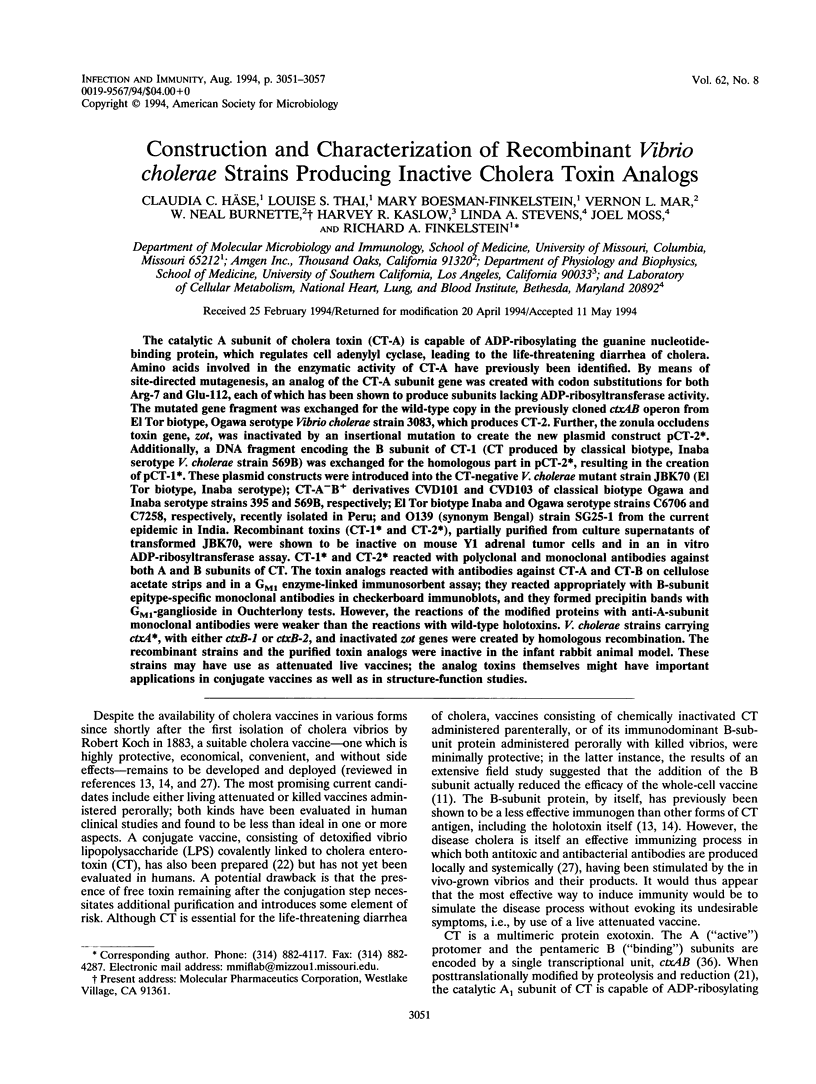
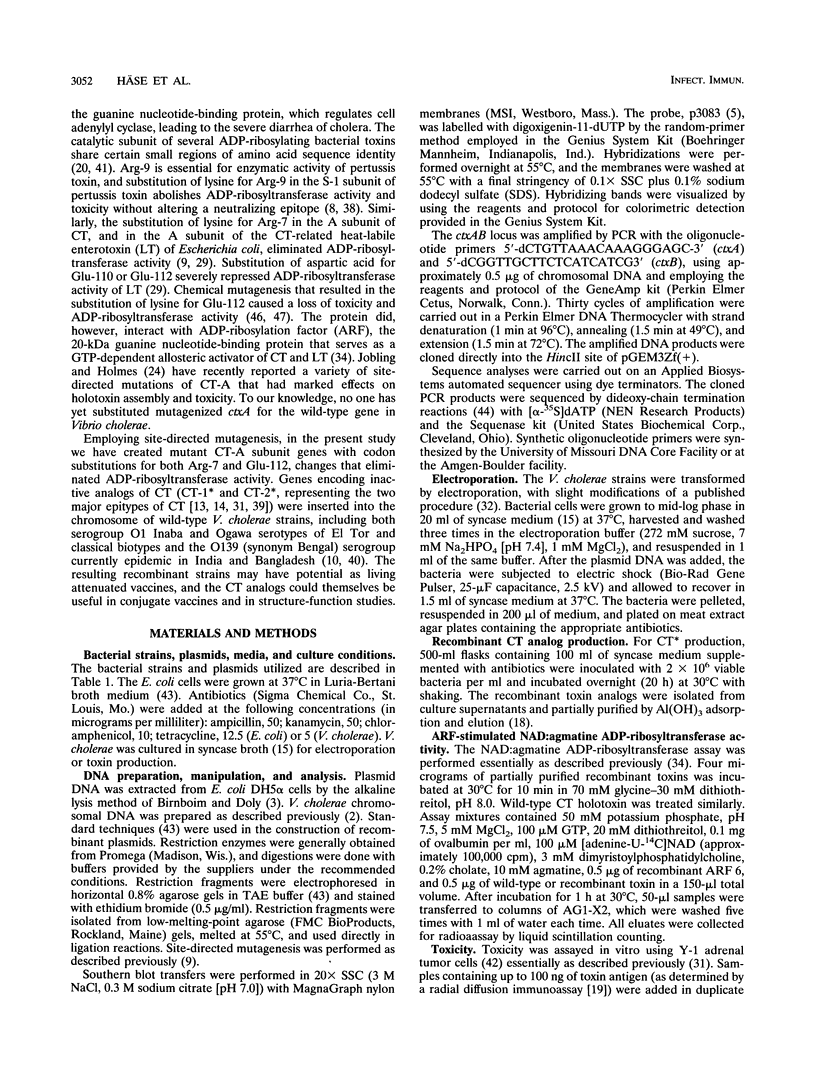
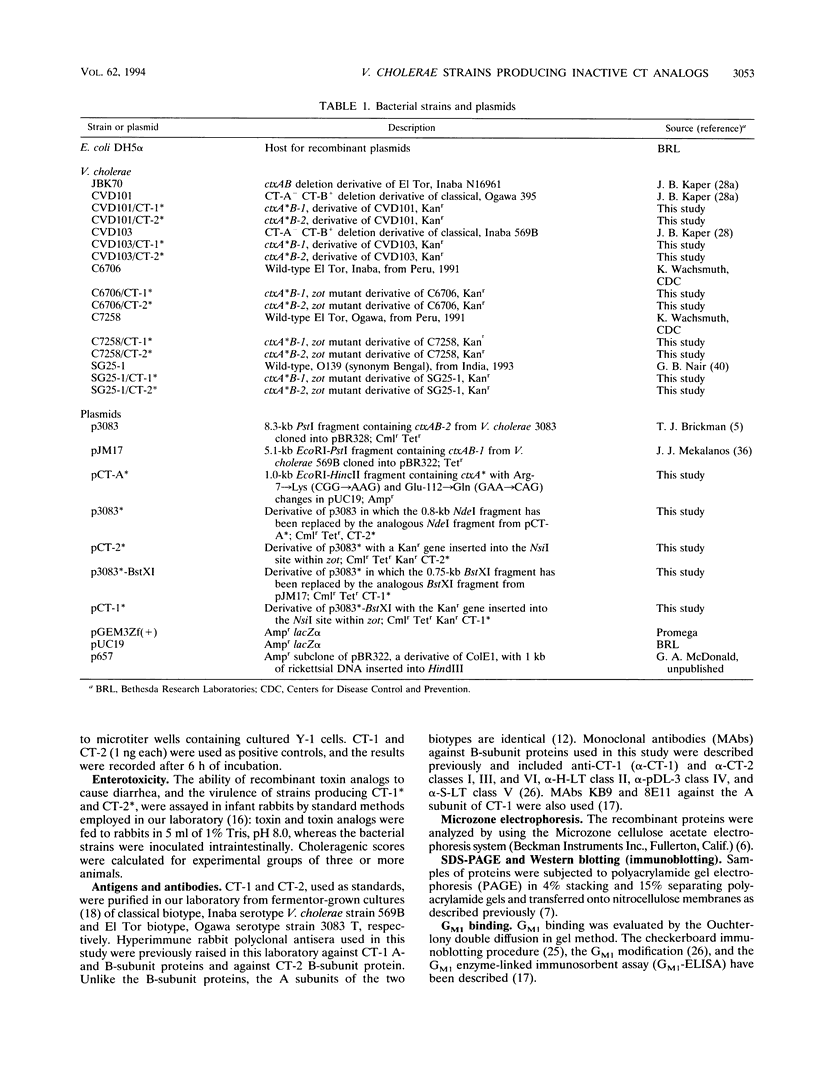
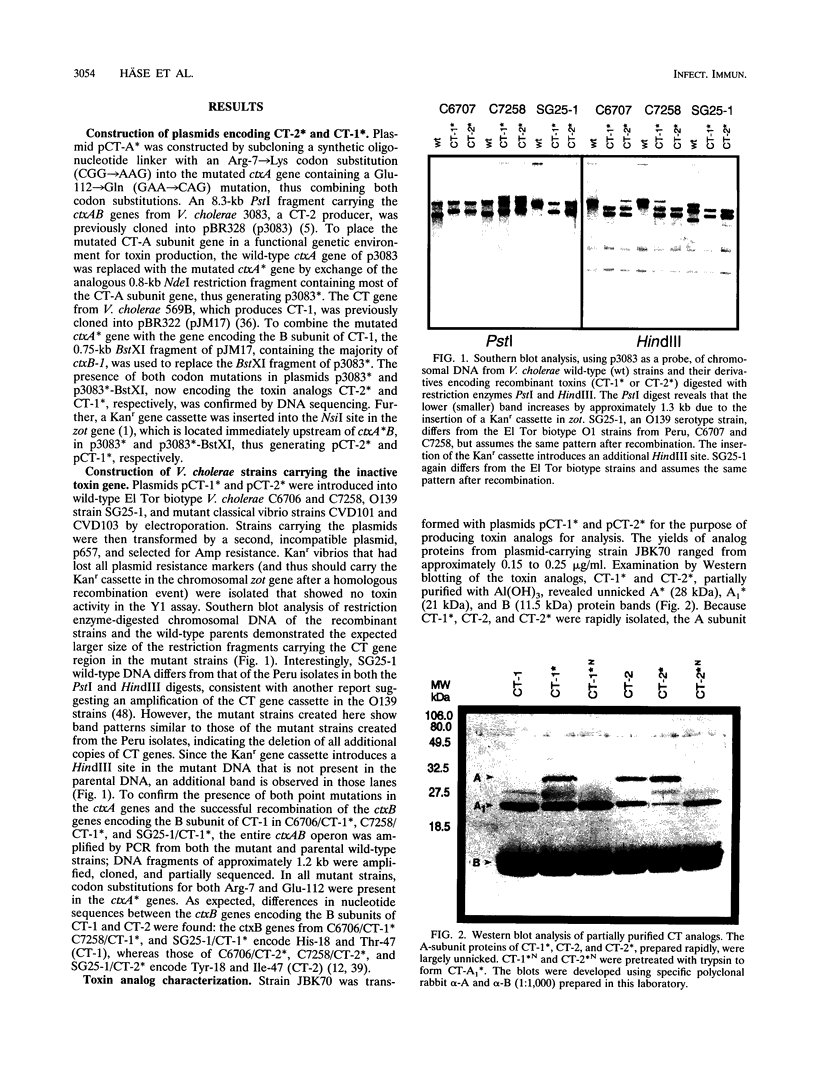
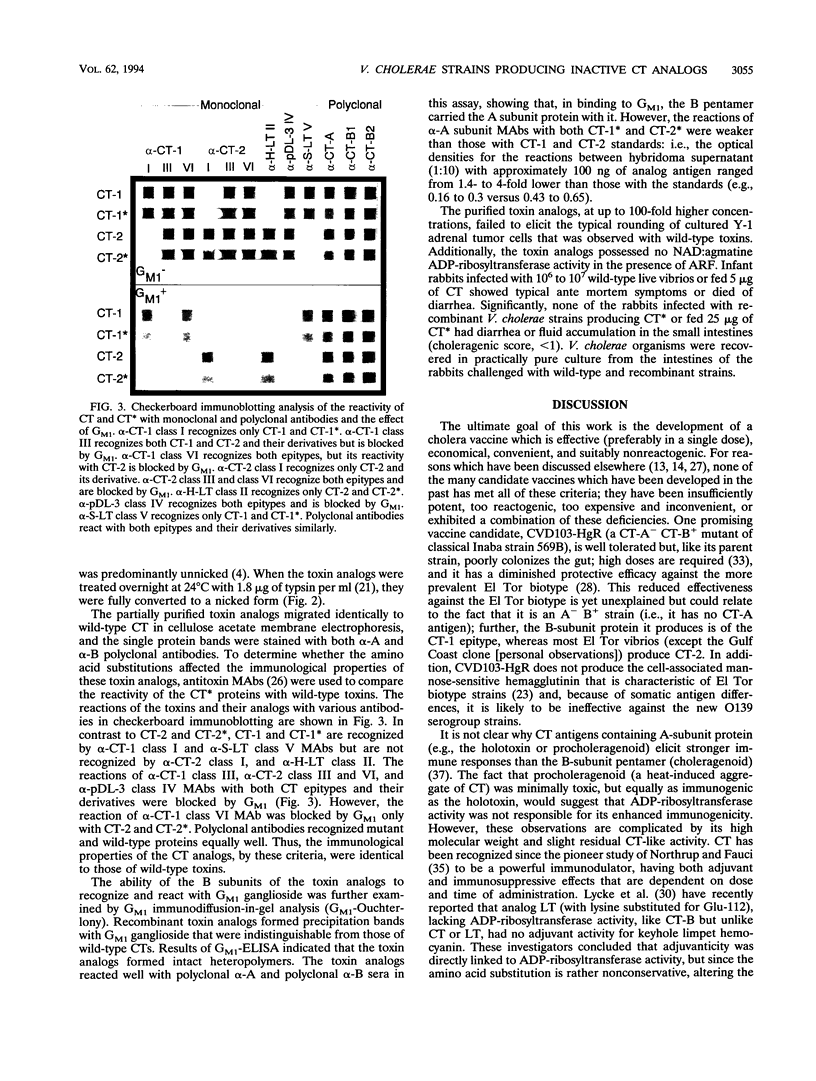
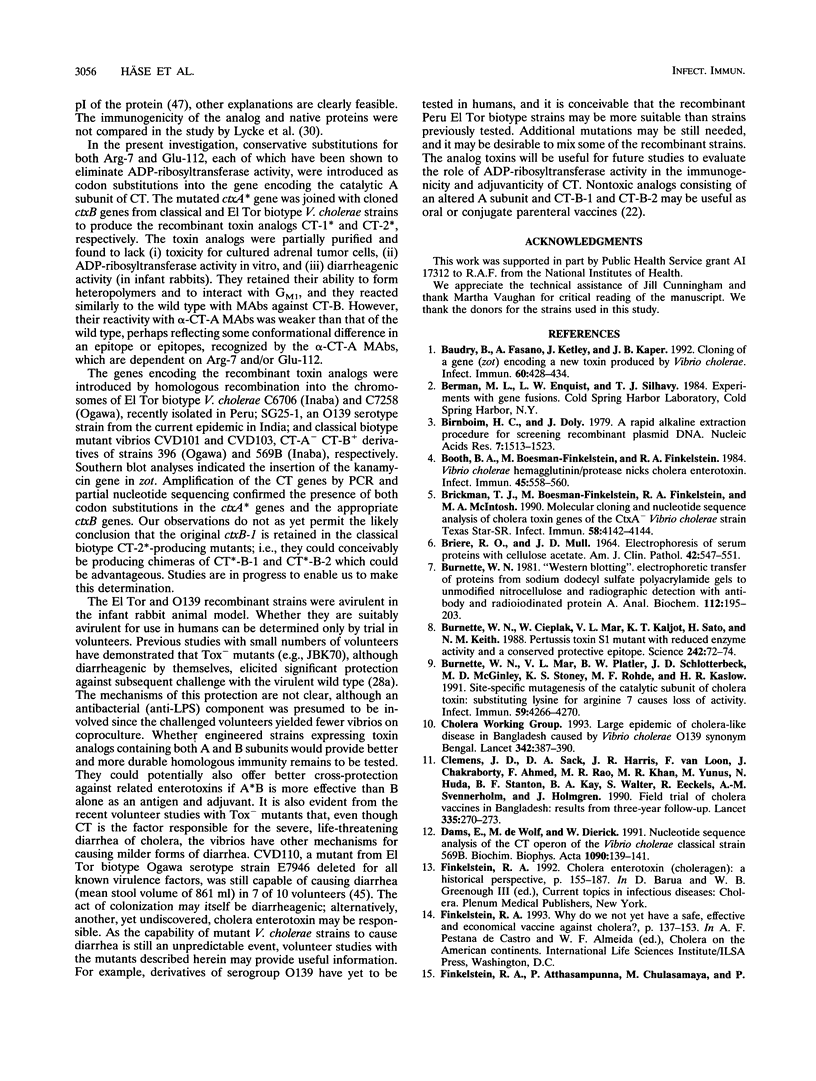
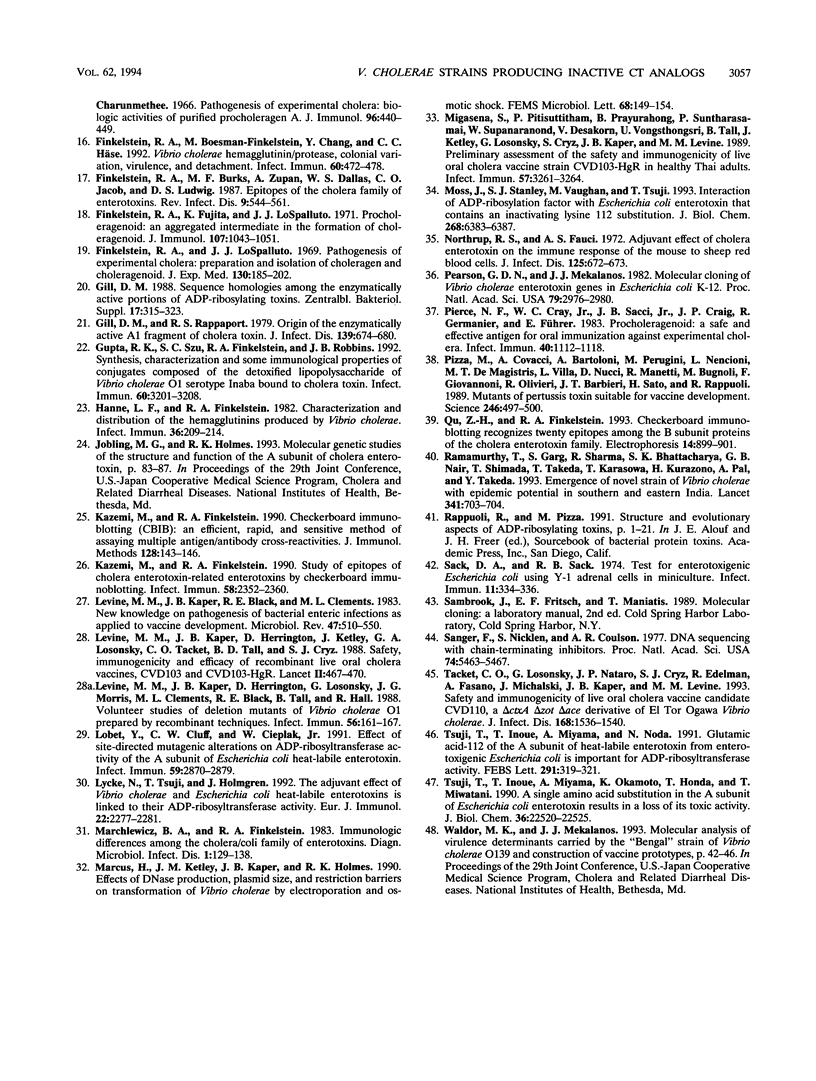
Images in this article
Selected References
These references are in PubMed. This may not be the complete list of references from this article.
- Baudry B., Fasano A., Ketley J., Kaper J. B. Cloning of a gene (zot) encoding a new toxin produced by Vibrio cholerae. Infect Immun. 1992 Feb;60(2):428–434. doi: 10.1128/iai.60.2.428-434.1992. [DOI] [PMC free article] [PubMed] [Google Scholar]
- Birnboim H. C., Doly J. A rapid alkaline extraction procedure for screening recombinant plasmid DNA. Nucleic Acids Res. 1979 Nov 24;7(6):1513–1523. doi: 10.1093/nar/7.6.1513. [DOI] [PMC free article] [PubMed] [Google Scholar]
- Booth B. A., Boesman-Finkelstein M., Finkelstein R. A. Vibrio cholerae hemagglutinin/protease nicks cholera enterotoxin. Infect Immun. 1984 Sep;45(3):558–560. doi: 10.1128/iai.45.3.558-560.1984. [DOI] [PMC free article] [PubMed] [Google Scholar]
- Brickman T. J., Boesman-Finkelstein M., Finkelstein R. A., McIntosh M. A. Molecular cloning and nucleotide sequence analysis of cholera toxin genes of the CtxA- Vibrio cholerae strain Texas Star-SR. Infect Immun. 1990 Dec;58(12):4142–4144. doi: 10.1128/iai.58.12.4142-4144.1990. [DOI] [PMC free article] [PubMed] [Google Scholar]
- Burnette W. N. "Western blotting": electrophoretic transfer of proteins from sodium dodecyl sulfate--polyacrylamide gels to unmodified nitrocellulose and radiographic detection with antibody and radioiodinated protein A. Anal Biochem. 1981 Apr;112(2):195–203. doi: 10.1016/0003-2697(81)90281-5. [DOI] [PubMed] [Google Scholar]
- Burnette W. N., Cieplak W., Mar V. L., Kaljot K. T., Sato H., Keith J. M. Pertussis toxin S1 mutant with reduced enzyme activity and a conserved protective epitope. Science. 1988 Oct 7;242(4875):72–74. doi: 10.1126/science.2459776. [DOI] [PubMed] [Google Scholar]
- Burnette W. N., Mar V. L., Platler B. W., Schlotterbeck J. D., McGinley M. D., Stoney K. S., Rohde M. F., Kaslow H. R. Site-specific mutagenesis of the catalytic subunit of cholera toxin: substituting lysine for arginine 7 causes loss of activity. Infect Immun. 1991 Nov;59(11):4266–4270. doi: 10.1128/iai.59.11.4266-4270.1991. [DOI] [PMC free article] [PubMed] [Google Scholar]
- Clemens J. D., Sack D. A., Harris J. R., Van Loon F., Chakraborty J., Ahmed F., Rao M. R., Khan M. R., Yunus M., Huda N. Field trial of oral cholera vaccines in Bangladesh: results from three-year follow-up. Lancet. 1990 Feb 3;335(8684):270–273. doi: 10.1016/0140-6736(90)90080-o. [DOI] [PubMed] [Google Scholar]
- Dams E., De Wolf M., Dierick W. Nucleotide sequence analysis of the CT operon of the Vibrio cholerae classical strain 569B. Biochim Biophys Acta. 1991 Aug 27;1090(1):139–141. doi: 10.1016/0167-4781(91)90050-v. [DOI] [PubMed] [Google Scholar]
- Finkelstein R. A., Atthasampunna P., Chulasamaya M., Charunmethee P. Pathogenesis of experimental cholera: biologic ativities of purified procholeragen A. J Immunol. 1966 Mar;96(3):440–449. [PubMed] [Google Scholar]
- Finkelstein R. A., Boesman-Finkelstein M., Chang Y., Häse C. C. Vibrio cholerae hemagglutinin/protease, colonial variation, virulence, and detachment. Infect Immun. 1992 Feb;60(2):472–478. doi: 10.1128/iai.60.2.472-478.1992. [DOI] [PMC free article] [PubMed] [Google Scholar]
- Finkelstein R. A., Burks M. F., Zupan A., Dallas W. S., Jacob C. O., Ludwig D. S. Epitopes of the cholera family of enterotoxins. Rev Infect Dis. 1987 May-Jun;9(3):544–561. doi: 10.1093/clinids/9.3.544. [DOI] [PubMed] [Google Scholar]
- Finkelstein R. A., Fujita K., LoSpalluto J. J. Procholeragenoid: an aggregated intermediate in the formation of choleragenoid. J Immunol. 1971 Oct;107(4):1043–1051. [PubMed] [Google Scholar]
- Finkelstein R. A., LoSpalluto J. J. Pathogenesis of experimental cholera. Preparation and isolation of choleragen and choleragenoid. J Exp Med. 1969 Jul 1;130(1):185–202. doi: 10.1084/jem.130.1.185. [DOI] [PMC free article] [PubMed] [Google Scholar]
- Gill D. M., Rappaport R. S. Origin of the enzymatically active A1 fragment of cholera toxin. J Infect Dis. 1979 Jun;139(6):674–680. doi: 10.1093/infdis/139.6.674. [DOI] [PubMed] [Google Scholar]
- Gupta R. K., Szu S. C., Finkelstein R. A., Robbins J. B. Synthesis, characterization, and some immunological properties of conjugates composed of the detoxified lipopolysaccharide of Vibrio cholerae O1 serotype Inaba bound to cholera toxin. Infect Immun. 1992 Aug;60(8):3201–3208. doi: 10.1128/iai.60.8.3201-3208.1992. [DOI] [PMC free article] [PubMed] [Google Scholar]
- Hanne L. F., Finkelstein R. A. Characterization and distribution of the hemagglutinins produced by Vibrio cholerae. Infect Immun. 1982 Apr;36(1):209–214. doi: 10.1128/iai.36.1.209-214.1982. [DOI] [PMC free article] [PubMed] [Google Scholar]
- Kazemi M., Finkelstein R. A. Checkerboard immunoblotting (CBIB): an efficient, rapid, and sensitive method of assaying multiple antigen/antibody cross-reactivities. J Immunol Methods. 1990 Mar 27;128(1):143–146. doi: 10.1016/0022-1759(90)90473-9. [DOI] [PubMed] [Google Scholar]
- Kazemi M., Finkelstein R. A. Study of epitopes of cholera enterotoxin-related enterotoxins by checkerboard immunoblotting. Infect Immun. 1990 Jul;58(7):2352–2360. doi: 10.1128/iai.58.7.2352-2360.1990. [DOI] [PMC free article] [PubMed] [Google Scholar]
- Levine M. M., Kaper J. B., Black R. E., Clements M. L. New knowledge on pathogenesis of bacterial enteric infections as applied to vaccine development. Microbiol Rev. 1983 Dec;47(4):510–550. doi: 10.1128/mr.47.4.510-550.1983. [DOI] [PMC free article] [PubMed] [Google Scholar]
- Levine M. M., Kaper J. B., Herrington D., Ketley J., Losonsky G., Tacket C. O., Tall B., Cryz S. Safety, immunogenicity, and efficacy of recombinant live oral cholera vaccines, CVD 103 and CVD 103-HgR. Lancet. 1988 Aug 27;2(8609):467–470. doi: 10.1016/s0140-6736(88)90120-1. [DOI] [PubMed] [Google Scholar]
- Levine M. M., Kaper J. B., Herrington D., Losonsky G., Morris J. G., Clements M. L., Black R. E., Tall B., Hall R. Volunteer studies of deletion mutants of Vibrio cholerae O1 prepared by recombinant techniques. Infect Immun. 1988 Jan;56(1):161–167. doi: 10.1128/iai.56.1.161-167.1988. [DOI] [PMC free article] [PubMed] [Google Scholar]
- Lobet Y., Cluff C. W., Cieplak W., Jr Effect of site-directed mutagenic alterations on ADP-ribosyltransferase activity of the A subunit of Escherichia coli heat-labile enterotoxin. Infect Immun. 1991 Sep;59(9):2870–2879. doi: 10.1128/iai.59.9.2870-2879.1991. [DOI] [PMC free article] [PubMed] [Google Scholar]
- Lycke N., Tsuji T., Holmgren J. The adjuvant effect of Vibrio cholerae and Escherichia coli heat-labile enterotoxins is linked to their ADP-ribosyltransferase activity. Eur J Immunol. 1992 Sep;22(9):2277–2281. doi: 10.1002/eji.1830220915. [DOI] [PubMed] [Google Scholar]
- Marchlewicz B. A., Finkelstein R. A. Immunological differences among the cholera/coli family of enterotoxins. Diagn Microbiol Infect Dis. 1983 Jun;1(2):129–138. doi: 10.1016/0732-8893(83)90042-1. [DOI] [PubMed] [Google Scholar]
- Marcus H., Ketley J. M., Kaper J. B., Holmes R. K. Effects of DNase production, plasmid size, and restriction barriers on transformation of Vibrio cholerae by electroporation and osmotic shock. FEMS Microbiol Lett. 1990 Mar 1;56(1-2):149–154. doi: 10.1111/j.1574-6968.1990.tb04139.x. [DOI] [PubMed] [Google Scholar]
- Migasena S., Pitisuttitham P., Prayurahong B., Suntharasamai P., Supanaranond W., Desakorn V., Vongsthongsri U., Tall B., Ketley J., Losonsky G. Preliminary assessment of the safety and immunogenicity of live oral cholera vaccine strain CVD 103-HgR in healthy Thai adults. Infect Immun. 1989 Nov;57(11):3261–3264. doi: 10.1128/iai.57.11.3261-3264.1989. [DOI] [PMC free article] [PubMed] [Google Scholar]
- Moss J., Stanley S. J., Vaughan M., Tsuji T. Interaction of ADP-ribosylation factor with Escherichia coli enterotoxin that contains an inactivating lysine 112 substitution. J Biol Chem. 1993 Mar 25;268(9):6383–6387. [PubMed] [Google Scholar]
- Northrup R. S., Fauci A. S. Adjuvant effect of cholera enterotoxin on the immune response of the mouse to sheep red blood cells. J Infect Dis. 1972 Jun;125(6):672–673. doi: 10.1093/infdis/125.6.672. [DOI] [PubMed] [Google Scholar]
- Pearson G. D., Mekalanos J. J. Molecular cloning of Vibrio cholerae enterotoxin genes in Escherichia coli K-12. Proc Natl Acad Sci U S A. 1982 May;79(9):2976–2980. doi: 10.1073/pnas.79.9.2976. [DOI] [PMC free article] [PubMed] [Google Scholar]
- Pierce N. F., Cray W. C., Jr, Sacci J. B., Jr, Craig J. P., Germanier R., Fürer E. Procholeragenoid: a safe and effective antigen for oral immunization against experimental cholera. Infect Immun. 1983 Jun;40(3):1112–1118. doi: 10.1128/iai.40.3.1112-1118.1983. [DOI] [PMC free article] [PubMed] [Google Scholar]
- Pizza M., Covacci A., Bartoloni A., Perugini M., Nencioni L., De Magistris M. T., Villa L., Nucci D., Manetti R., Bugnoli M. Mutants of pertussis toxin suitable for vaccine development. Science. 1989 Oct 27;246(4929):497–500. doi: 10.1126/science.2683073. [DOI] [PubMed] [Google Scholar]
- Qu Z. H., Finkelstein R. A. Checkerboard immunoblotting recognizes twenty epitopes among the B subunit proteins of the cholera enterotoxin family. Electrophoresis. 1993 Sep;14(9):899–901. doi: 10.1002/elps.11501401143. [DOI] [PubMed] [Google Scholar]
- Ramamurthy T., Garg S., Sharma R., Bhattacharya S. K., Nair G. B., Shimada T., Takeda T., Karasawa T., Kurazano H., Pal A. Emergence of novel strain of Vibrio cholerae with epidemic potential in southern and eastern India. Lancet. 1993 Mar 13;341(8846):703–704. doi: 10.1016/0140-6736(93)90480-5. [DOI] [PubMed] [Google Scholar]
- Sack D. A., Sack R. B. Test for enterotoxigenic Escherichia coli using Y-1 adrenal cells in miniculture. Infect Immun. 1975 Feb;11(2):334–336. doi: 10.1128/iai.11.2.334-336.1975. [DOI] [PMC free article] [PubMed] [Google Scholar]
- Sanger F., Nicklen S., Coulson A. R. DNA sequencing with chain-terminating inhibitors. Proc Natl Acad Sci U S A. 1977 Dec;74(12):5463–5467. doi: 10.1073/pnas.74.12.5463. [DOI] [PMC free article] [PubMed] [Google Scholar]
- Tacket C. O., Losonsky G., Nataro J. P., Cryz S. J., Edelman R., Fasano A., Michalski J., Kaper J. B., Levine M. M. Safety and immunogenicity of live oral cholera vaccine candidate CVD 110, a delta ctxA delta zot delta ace derivative of El Tor Ogawa Vibrio cholerae. J Infect Dis. 1993 Dec;168(6):1536–1540. doi: 10.1093/infdis/168.6.1536. [DOI] [PubMed] [Google Scholar]
- Tsuji T., Inoue T., Miyama A., Noda M. Glutamic acid-112 of the A subunit of heat-labile enterotoxin from enterotoxigenic Escherichia coli is important for ADP-ribosyltransferase activity. FEBS Lett. 1991 Oct 21;291(2):319–321. doi: 10.1016/0014-5793(91)81311-u. [DOI] [PubMed] [Google Scholar]
- Tsuji T., Inoue T., Miyama A., Okamoto K., Honda T., Miwatani T. A single amino acid substitution in the A subunit of Escherichia coli enterotoxin results in a loss of its toxic activity. J Biol Chem. 1990 Dec 25;265(36):22520–22525. [PubMed] [Google Scholar]





